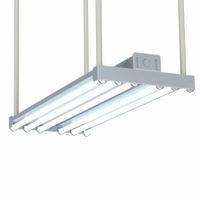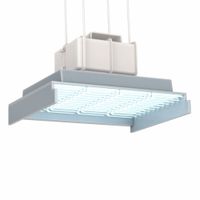Call +(254) 703 030 000 / 751 483 999 / 721 704 777
- Home
- Lighting
- Lighting Fixtures Retrofit Kits
- Bay Lights
Bay Lights
Bay lights deliver bright, uniform illumination from high ceilings or open trusses to floors and work surfaces below. They mount at greater heights than other types of overhead indoor lighting fixtures to illuminate warehouses, factories, gymnasiums, hangars, big-box stores, and other large, open sp .....Read More
Frequently Asked Questions
What are bay lights used for?
Bay lights are used to illuminate large indoor spaces with high ceilings, such as warehouses, factories, gymnasiums, and big-box retail stores. These lights are specifically designed to provide bright, uniform lighting over a wide area, ensuring visibility and safety in environments where tasks require precision and attention to detail.
There are two main types of bay lights: high bay lights and low bay lights. High bay lights are used for ceilings that are 20 feet or higher, while low bay lights are suitable for ceilings between 12 to 20 feet. The choice between high and low bay lights depends on the height of the ceiling and the specific lighting needs of the space.
Bay lights are typically mounted directly to the ceiling or suspended from it, and they come in various forms, including LED, fluorescent, and metal halide. LED bay lights are particularly popular due to their energy efficiency, long lifespan, and low maintenance requirements. They provide bright, consistent light output and can significantly reduce energy costs compared to traditional lighting options.
In addition to general illumination, bay lights can be equipped with features such as motion sensors, dimming capabilities, and smart controls, allowing for further energy savings and customization of lighting conditions. This adaptability makes them suitable for a wide range of applications, from industrial settings to commercial spaces.
Overall, bay lights are essential for ensuring adequate lighting in large, high-ceilinged spaces, contributing to improved productivity, safety, and energy efficiency.
What is the difference between high bay and low bay lights?
High bay lights are designed for ceilings that are 20 feet or higher, typically found in industrial and commercial settings like warehouses, factories, and gymnasiums. They provide a broad, powerful light distribution to illuminate large areas from a significant height. High bay lights often use reflectors or lenses to direct light downward and minimize glare, ensuring even coverage over expansive spaces.
Low bay lights, on the other hand, are intended for ceilings that are between 12 to 20 feet high, commonly used in retail stores, workshops, and garages. They offer a more focused light distribution suitable for lower ceilings, providing adequate illumination without overwhelming the space. Low bay lights typically have a wider beam angle to cover the area effectively at a lower height.
The primary differences between high bay and low bay lights include their installation height, light distribution, and design features tailored to their specific applications. High bay lights are more powerful and designed to cover larger areas from greater heights, while low bay lights are optimized for closer proximity to the ground, offering more concentrated lighting for smaller spaces.
How do I choose the right bay light for my space?
To choose the right bay light for your space, consider the following factors:
1. **Ceiling Height**: Determine if you need high bay lights (for ceilings above 20 feet) or low bay lights (for ceilings below 20 feet).
2. **Lumens and Wattage**: Calculate the lumens required based on the size and purpose of the space. Higher lumens are needed for larger or more task-oriented areas. Choose wattage that provides the necessary lumens efficiently.
3. **Beam Angle**: Select a beam angle that suits your space. Narrow angles (e.g., 60°) focus light on specific areas, while wider angles (e.g., 120°) cover larger spaces.
4. **Color Temperature**: Decide on the color temperature based on the ambiance and functionality. Cooler temperatures (5000K-6500K) are ideal for workspaces, while warmer temperatures (3000K-4000K) create a more relaxed atmosphere.
5. **CRI (Color Rendering Index)**: Opt for a higher CRI (above 80) for spaces where color accuracy is important, such as retail or design areas.
6. **Energy Efficiency**: Look for LED bay lights for better energy efficiency and longer lifespan compared to traditional lighting.
7. **Dimming and Controls**: Consider lights with dimming capabilities or smart controls for flexibility in lighting levels and energy savings.
8. **Installation and Maintenance**: Ensure the lights are easy to install and maintain, especially in high or hard-to-reach areas.
9. **Budget**: Balance initial costs with long-term savings from energy efficiency and reduced maintenance.
10. **Compliance and Safety**: Check for compliance with local regulations and safety standards.
By evaluating these factors, you can select bay lights that meet your space's specific needs effectively.
What are the benefits of using LED bay lights?
LED bay lights offer numerous benefits, making them a popular choice for industrial and commercial spaces. Firstly, they are highly energy-efficient, consuming significantly less electricity compared to traditional lighting options like metal halide or fluorescent lights. This efficiency translates to lower energy bills and reduced carbon footprint.
Secondly, LED bay lights have a longer lifespan, often lasting up to 50,000 hours or more. This longevity reduces the frequency of replacements, leading to lower maintenance costs and less disruption in operations.
Thirdly, they provide superior lighting quality. LEDs offer bright, clear illumination with high color rendering index (CRI), which enhances visibility and safety in work environments. They also have instant-on capabilities, eliminating the warm-up time associated with other lighting types.
Additionally, LED bay lights are highly durable and resistant to shock, vibrations, and external impacts, making them suitable for harsh industrial environments. They also operate efficiently in a wide range of temperatures, ensuring consistent performance in various conditions.
LEDs are environmentally friendly, as they contain no hazardous materials like mercury, and are fully recyclable. This makes them a sustainable choice for businesses aiming to reduce their environmental impact.
Moreover, LED bay lights offer flexibility in design and installation. They come in various shapes and sizes, allowing for customization to fit specific lighting needs. They can also be easily integrated with smart controls and sensors for automated lighting solutions, further enhancing energy savings.
In summary, LED bay lights provide energy efficiency, long lifespan, superior lighting quality, durability, environmental benefits, and design flexibility, making them an ideal lighting solution for large spaces.
How high should high bay lights be mounted?
High bay lights should be mounted at different heights depending on the specific application and the level of illumination required. Generally, high bay lights are used in spaces with ceilings ranging from 20 to 45 feet. Here are some guidelines for mounting heights:
1. **Ceiling Height 15-20 feet**: For lower high bay applications, lights should be mounted at a height of 15 to 20 feet. This is suitable for spaces like small warehouses or retail stores. A lumen output of 10,000 to 15,000 lumens is typically adequate.
2. **Ceiling Height 20-30 feet**: For medium high bay applications, lights should be mounted at a height of 20 to 30 feet. This is common in larger warehouses or manufacturing facilities. A lumen output of 16,000 to 20,000 lumens is recommended.
3. **Ceiling Height 30-40 feet**: For higher high bay applications, lights should be mounted at a height of 30 to 40 feet. This is ideal for large industrial spaces or sports arenas. A lumen output of 33,000 lumens or more is often necessary.
4. **Ceiling Height 40-45 feet and above**: For very high ceilings, lights should be mounted at 40 to 45 feet or higher. This is suitable for very large facilities or specialized applications. High lumen output fixtures, often exceeding 40,000 lumens, are required to ensure adequate illumination.
The spacing between fixtures also plays a crucial role in achieving uniform lighting. For example, for a ceiling height of 20 feet, fixtures should be spaced approximately 15 feet apart for normal lighting and 12 feet apart for brighter lighting. Adjustments may be needed based on specific lighting needs, fixture types, and the reflectivity of surfaces within the space.
What is the typical lifespan of LED bay lights?
The typical lifespan of LED bay lights ranges from 50,000 to 100,000 hours. This longevity is significantly higher compared to traditional lighting solutions like incandescent or fluorescent lights. The lifespan of LED bay lights can be influenced by several factors, including the quality of the LED chips, the design of the fixture, the operating environment, and the thermal management system in place.
High-quality LED bay lights, which use premium components and have efficient heat dissipation mechanisms, tend to last longer. Proper thermal management is crucial because excessive heat can degrade the LED chips and reduce their lifespan. LED bay lights are often used in industrial and commercial settings, such as warehouses and factories, where they are subject to continuous operation. In such environments, the durability and efficiency of LED bay lights make them a cost-effective choice over time.
The lifespan of LED bay lights is also affected by the operating conditions. For instance, lights used in environments with high temperatures or humidity may experience a reduced lifespan. Conversely, operating them in optimal conditions can help achieve the upper end of their lifespan range.
LED bay lights maintain a high level of brightness throughout most of their life, with a gradual decrease in light output towards the end. This is often referred to as "lumen depreciation." The industry standard for determining the end of an LED's useful life is when it reaches 70% of its initial light output, known as L70.
Overall, the extended lifespan of LED bay lights, combined with their energy efficiency and low maintenance requirements, makes them a popular choice for large-scale lighting applications.
How do bay lights compare to other types of lighting in terms of energy efficiency?
Bay lights, particularly LED high bay lights, are highly energy-efficient compared to other types of lighting. They are designed for illuminating large spaces with high ceilings, such as warehouses, factories, and gymnasiums. Here’s how they compare in terms of energy efficiency:
1. **LED Technology**: LED bay lights consume significantly less energy than traditional lighting options like metal halide, fluorescent, or high-pressure sodium lights. They convert a higher percentage of electricity into visible light, reducing energy waste.
2. **Luminous Efficacy**: LED bay lights have a high luminous efficacy, often exceeding 100 lumens per watt, which means they produce more light per unit of energy consumed compared to other lighting technologies.
3. **Long Lifespan**: LEDs have a longer operational life, often exceeding 50,000 hours, which reduces the frequency of replacements and maintenance costs. This longevity contributes to overall energy savings as fewer resources are used over time.
4. **Reduced Heat Emission**: LED bay lights emit less heat compared to incandescent or metal halide lights, which means less energy is wasted as heat. This also reduces the load on air conditioning systems, further saving energy.
5. **Dimmability and Controls**: Many LED bay lights are compatible with dimming and smart controls, allowing for further energy savings by adjusting light levels based on occupancy or daylight availability.
6. **Instant On/Off**: Unlike some traditional lighting, LED bay lights turn on and off instantly without warm-up time, ensuring energy is only used when needed.
Overall, LED bay lights offer superior energy efficiency, reduced operational costs, and environmental benefits compared to other lighting types, making them a preferred choice for large-scale lighting applications.



